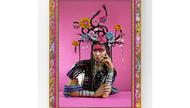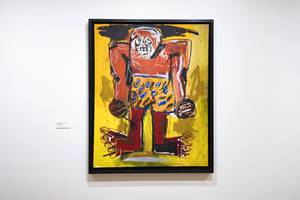Behold the rare exhibit that will appeal to art lovers and loathers alike. Even if you don’t give two figs about art, you’ll be moved by the astounding Ann and Gabriel Barbier-Mueller Collection of more than 50 samurai armor pieces. It will transport you to another world, one rich in meaning, symbolism and craftsmanship.
Unlike so many art shows, which celebrate the genius of one overly special artiste, this exhibit is all encompassing in its detailed portrayal of Bushidō or “the way of the warrior.” Countless anonymous craftsmen—experts in leatherwork, metallurgy, brocade, weaving, enamelwork and more—came together to build these masterpieces, which were passed down over generations and updated to fit the era. The pieces date from the 14th to 19th century—that’s 600 years! In that time, weapons of war evolved from bows and arrows to guns, as the Samurai themselves evolved from battlefield knights to peacetime ceremonial bureaucrats.
The rare full sets of armor are most striking, and this exhibit boasts several. Displayed as if they were being worn, it’s easy to imagine that the costumes might roar to life. Each piece of the suite is a work of art in and of itself—both light and strong, intimidating yet easy to wear. They include bear fur shoes (kutsu), shin guards (suneate), skirt panels (kusazuri), sleeves (kote), shoulder guards (sode), pieces of chest armor (dō), masks (menpō) and helmets (kabuto).
In a time before mass production, no detail was spared for these elite fighters. Flat surfaces were adorned with mythical and religious motifs to bring the wearer luck and strength. Woven armor plates allowed for dexterity. Sculpted crests (maedate) or helmet toppers added an extra level of intimidation and adornment. One unforgettable crest is a mythical bird fish made out of lacquer, gold and horsehair. It’s ferocious.
Metal masks bear exaggerated and angry facial expressions to scare the enemy while protecting the wearer. Red paint lines the masks’ lips, which increases visibility and protects against rust. Tiny circular pieces decorate the bottom of masks and allow for sweat to drip out. Each mask in the collection is unique in style and design, but most of them have tiny hooks so the wearer could remove the nose piece for greater comfort.
The viewer will be amazed to discover how the culture changed and evolved over time. One group of helmets looks oddly European. They were influenced by visiting Spanish and Portuguese sailors. For a moment, the hats were the height of fashion because they were considered “exotic.” Later, when guns made battlefields too smokey for fighters to see clearly, helmets grew large and distinctive, such as the one that looks like a giant seashell (enameled papier-mâché keeps the weight low).
The pieces tell a story of regal families of vast wealth who bear crests—just like in Game of Thrones. One samurai sword’s mount bears 135 sigils of the owner’s family. It’s fun to speculate about whether the families whose regalia is on display together might have been sworn enemies. Today, they are united in beauty.
Samurai: Armor From the Ann and Gabriel Barbier-Mueller Collection Through April 29; daily, 10 a.m. 8 p.m., $16-$18. Bellagio Gallery of Fine Art, 702-693-7871.







